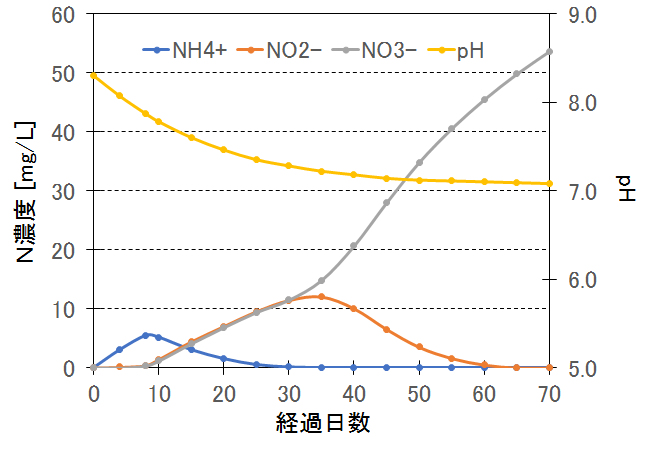Biological nitrification
村上定瞭(水浄化フォーラム), Sadaaki Murakami (Water & Solutions Forum)
アンモニアの酸化-硝化
硝化細菌の活性(反応速度、増殖速度)は、水温、pH、DO等の環境条件の影響を受けやすいが、一般的に硝化反応は下式で示される。
Ammonia oxidation-nitrification
The activity (reaction rate, growth rate) of nitrifying bacteria is easily affected by environmental conditions such as water temperature, pH, DO, etc. In general, the nitrification reaction is represented by the following formula.
① NH4+ + 3/2O2 → NO2– + 2H+ + H2O
② NO2– + 1/2O2 → NO2–
③ NH4+ + 2O2 → NO3– + 2H+ + H2O
② NO2– + 1/2O2 → NO2–
③ NH4+ + 2O2 → NO3– + 2H+ + H2O

図 循環生物ろ過式の海水魚飼育水槽(屋内閉鎖系、15℃)での窒素およびpHの経日変化事例
Figure Example of daily changes of nitrogen and pH in a saltwater fish tank with circulating biological filtration (indoor closed system, 15° C)
アンモニアから亜硝酸を生成するには、ニトロソモナス属(Nitorosomonas sp.)、ニトロコッカス属(Nitrosococus sp.)等の硝化細菌の作用によって進む。次に、亜硝酸から硝酸を生成する反応は、ニトロバクター属(Nitrobacter sp.)等の硝化細菌の作用によって進む。
アンモニアNH4+(1モル)をNO3–(1モル)へ酸化するには、酸素O2(2モル)が必要で、水素イオンH+(2モル)が生成しpHが低下する。
実際の硝化反応では、pHは6.8~8.5に保つことが望ましい。浮遊型培養反応、例えば活性汚泥法では、汚泥滞留日数を7日以上とする。微生物を担体等へ付着培養する生物膜法では、硝化菌に必要な汚泥滞留日数は十分保たれている。適温は20~30℃であるが、15℃以下では硝化速度は著しく低下する。
有機物濃度が高い(およそ30mg/L以上)と硝化反応はほとんど進行しないので、反応槽内の有機物濃度が低く保たれるよう十分な処理時間(水理学的滞留時間)を確保する。溶存酸素濃度は2mg/L以上が望ましい。
アンモニアNH4+(1モル)をNO3–(1モル)へ酸化するには、酸素O2(2モル)が必要で、水素イオンH+(2モル)が生成しpHが低下する。
実際の硝化反応では、pHは6.8~8.5に保つことが望ましい。浮遊型培養反応、例えば活性汚泥法では、汚泥滞留日数を7日以上とする。微生物を担体等へ付着培養する生物膜法では、硝化菌に必要な汚泥滞留日数は十分保たれている。適温は20~30℃であるが、15℃以下では硝化速度は著しく低下する。
有機物濃度が高い(およそ30mg/L以上)と硝化反応はほとんど進行しないので、反応槽内の有機物濃度が低く保たれるよう十分な処理時間(水理学的滞留時間)を確保する。溶存酸素濃度は2mg/L以上が望ましい。
The production of nitrite from ammonia proceeds by the action of nitrifying bacteria such as Nitorosomonas sp and Nitrosococus sp. Next, the reaction of producing nitric acid from nitrous acid proceeds by the action of nitrifying bacteria such as Nitrobacter sp.
Oxygen O2 (2mol) is required to oxidize ammonia NH4+(1mol) to NO3– (1mol) , and hydrogen ion H+ (2mol) is generated and the pH is lowered.
In the actual nitrification reaction, it is desirable to keep the pH at 6.8 to 8.5. In the floating culture reaction, for example, the activated sludge method, the sludge retention period is set to 7 days or more. In the biofilm reactors in which microorganisms are adhered and cultured on a carrier or the like, the sludge retention days required for nitrifying bacteria are sufficiently maintained. The optimum temperature is 20 to 30 ° C, but the nitrification rate decreases significantly below 15 ° C.
If the concentration of organic substances is high (about 30 mg/L or more), the nitrification reaction hardly progresses, so secure a sufficient treatment time (hydraulic retention time) to keep the concentration of organic substances low in the reaction tank. The dissolved oxygen concentration is preferably 2 mg/L or more.
Oxygen O2 (2mol) is required to oxidize ammonia NH4+(1mol) to NO3– (1mol) , and hydrogen ion H+ (2mol) is generated and the pH is lowered.
In the actual nitrification reaction, it is desirable to keep the pH at 6.8 to 8.5. In the floating culture reaction, for example, the activated sludge method, the sludge retention period is set to 7 days or more. In the biofilm reactors in which microorganisms are adhered and cultured on a carrier or the like, the sludge retention days required for nitrifying bacteria are sufficiently maintained. The optimum temperature is 20 to 30 ° C, but the nitrification rate decreases significantly below 15 ° C.
If the concentration of organic substances is high (about 30 mg/L or more), the nitrification reaction hardly progresses, so secure a sufficient treatment time (hydraulic retention time) to keep the concentration of organic substances low in the reaction tank. The dissolved oxygen concentration is preferably 2 mg/L or more.
本サイト内の関連ページ
観賞魚水槽
活魚水槽ー設計と維持管理
窒素除去
浄化槽の仕組みと方式
生物膜法による水処理
農業と環境-窒素循環-
現場での簡易水質検査・測定
Related pages on this site
Ornamental fish tank
Design and maintenance of live fish tank
Nitrogen removal
Mechanism and equipment of septic tank in Japan
Biofilm reactors for water treatment
Agriculture and environment – Nitrogen cycle –
Simple water quality inspection and measurement on site
掲載日:2017年05月09日
更新日:2020年05月28日
Posted: May 28, 2020
